- Scientific name: Opuntia humifusa
- Species of Greatest Conservation Need (MA State Wildlife Action Plan)
- Endangered (MA Endangered Species Act)
Description
Eastern prickly pear is a native perennial in the cactus family (Cactaceae) that spreads along the ground and grows to 0.5 m (1.6 ft) tall. The pads (stem segments) are glossy green and have areolas (areas where spines are attached) with minute, barbed, deciduous spines called glochids. Some plants also have two longer spines. The flowers are large and showy, with yellow tepals (petals and sepals that are similar); the fruit is fleshy and green initially, becoming pinkish-red as it matures. This species can reproduce by seed or vegetatively by detachment of the pads.
Eastern prickly pear can be observed any time of year, though it is easiest to find in summer when the showy yellow flowers are present. The pads are oblong-obovate, about 5-17.5 cm (2-6.9 in) × 4-12 cm (1.6-4.7 in) in size, and dark to shiny green with areolas arranged in a diagonal pattern. The areolas have whitish-brownish glochids that are about 4 mm (0.16 in) in length, with or without stout, longer spines. The pale to bright yellow flowers are 20-30 mm (0.8-1.2 in) across. The fleshy fruits are cylindric, 30-50 mm (1.2-2 in) long × 12-20 mm (0.5-0.8 in) wide, and taper slightly toward the base. The sour, green pulp ripens to reddish and becomes sweet and edible. Numerous seeds within the fruit are roundish and 3.5-4.5 mm (0.14-0.18 in), with a 1 mm (0.04 in) ridge.
Other prickly pear species are not known from Massachusetts; this species differs from other closely related Opuntia species by its strictly yellow tepals. Prairie prickly pear (Opuntia macrorhiza) flowers have a reddish center and little prickly pear (Opuntia fragilis) has greenish-yellow flowers. Eastern prickly pear only occasionally has long spines, whereas other species frequently have two or more long spines at most areolas.
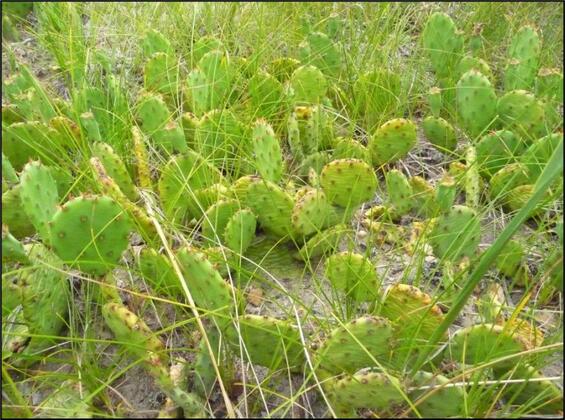
Eastern prickly pear characteristic spreading growth form.
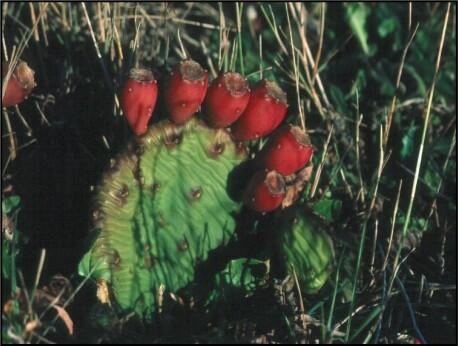
Fruit
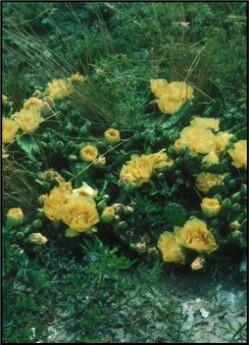
Flowers
Life cycle and behavior
This is a perennial species.
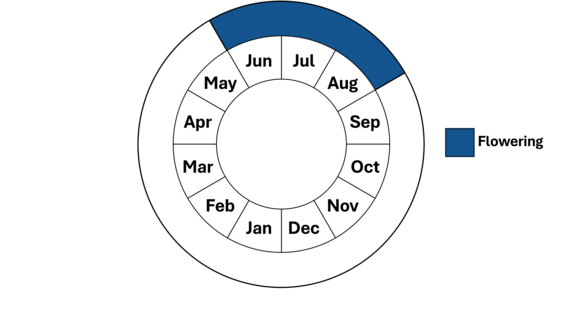
Population status
Eastern prickly pear is listed under the Massachusetts Endangered Species Act as endangered. All listed species are protected from killing, collecting, possessing, or sale, and from activities that would destroy habitat and thus directly or indirectly cause mortality or disrupt critical behaviors. The Massachusetts Natural Heritage & Endangered Species Program has 36 records from 5 counties: Barnstable, Dukes, Essex, Middlesex, and Nantucket. Ten of these records have been observed within the last 25 years. Eastern prickly pear was known to grow in coastal dune communities as early as the 1830s. It has been documented at Native American archaeological sites in the eastern US, presumably because of its sweet, edible fruits. It is unknown whether Native Americans may have introduced this species to Massachusetts.
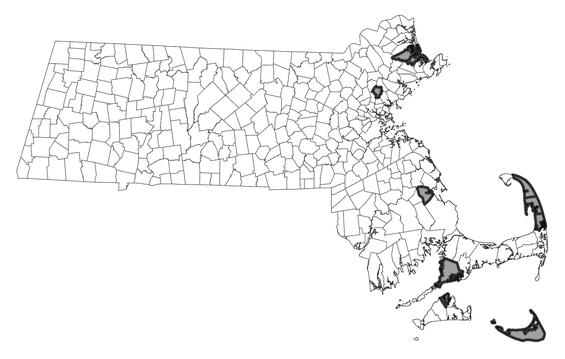
Distribution in Massachusetts. 1999-2024. Based on records in the Natural Heritage Database.
Distribution and abundance
Massachusetts is at the northern range limit for eastern prickly pear. It is found from Massachusetts south to Florida and west to Wisconsin and southern Ontario; it is not known to occur naturally in Rhode Island.
Habitat
Eastern prickly pear occurs in coastal Massachusetts in open dunes, low sandy knolls, grasslands and heathlands, and in sunny openings in pine barrens and maritime woodlands. Associated species often include red cedar (Juniperus virginiana), bayberry (Morella pensylvanica), dunegrass (Ammophila breviligulata), seaside goldenrod (Solidago sempervirens), and poison ivy (Toxicodendron radicans). Eastern prickly pear has also been found under power lines and in sandy lawns and cemeteries, and it is occasionally planted near dwellings.
Healthy habitats are vital for supporting native wildlife and plants. Explore habitats and learn about conservation and restoration in Massachusetts.
Threats
Primary threats to eastern prickly pear are trampling from vehicles, loss of habitat to development, and competition with invasive plants.
Conservation
Roads and other developments in the coastal region should avoid populations of eastern prickly pear. Fencing and re-directing of trails and off-road vehicle roads may help to protect known populations. Caution is needed to avoid plants during mowing. Invasive species removal and control of encroaching native vegetation may be necessary to prevent shading and competition. Natural threats such as storm surges may not be avoidable but plants in eroding areas may be moved or introduced to safer locations with appropriate habitat. Introduction to new locations may be done vegetatively by detached pads or by seeds. All active management of rare plant populations (including invasive species removal) is subject to review under the Massachusetts Endangered Species Act and should be planned in close consultation with the MassWildlife’s Natural Heritage & Endangered Species Program.
References
Gleason, H. A., and A. Cronquist. 1991. Manual of Vascular Plants of Northeastern United States and Adjacent Canada, 2nd edition. The New York Botanical Garden, Bronx, NY.
Haines, A. 2011. Flora Novae Angliae – a Manual for the Identification of Native and Naturalized Higher Vascular Plants of New England. New England Wildflower Society, Yale Univ. Press, New Haven, CT.
Wallace, R. S., and D. E. Fairbrothers. 1987. The New England distribution of Opuntia humifusa (Raf.) Raf. Rhodora 89: 327-332.
Contact
| Date published: | May 9, 2025 |
|---|